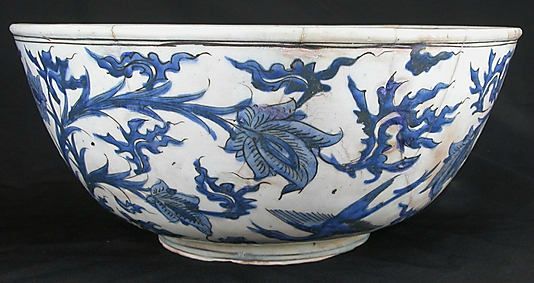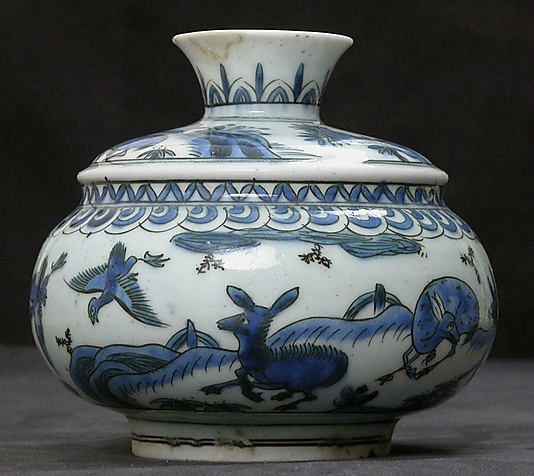![182958_274061492740427_2061911342_n]()
The contents of Trelissick House, subsequently owned by the Copeland family and including the Spode-Copeland Collection of ceramics, were sold by Bonhams in an on-site house sale. Photo: Bonhams.
International interest from America, Europe and China boosted the Bonhams sale of the contents of Trelissick House near Truro in Cornwall, this week, more than doubling the top pre-sale estimate of £1.5m to a final total of £3,269,238. Every item in the sale found a buyer.
The two-day 835 lot sale on July 23 and 24 created excitement across Cornwall and far beyond. The three sale preview days saw over 2,000 people at Trelissick House eager to see the legendary Spode ceramic collection and the many other fine objects in the sale including furniture, silver, porcelain and pictures.
Top items in the sale included an 18th century Chinese Quinlong era vase which made £337,250, a George II partners desk in the manner of Thomas Chippendale at £58,850, a Regence walnut, elm and rosewood ebony and ivory commode at £43,250, a John Frederick Herring picture of a bay racehorse in a stable for £31,250, two Chinese Kangxi vases £181,250, and a Victorian silver ten piece garniture at £39,650. At the other end of the scale, a charming if modest set of silver sandwich name tags made £5,000.
Roger Tappin, Bonhams Regional Director in Cornwall, said after the sale| "The result exceeded all our expectations. Interest from three continents drove prices ever upwards. The sale was broadcast live round the world and bidding was fierce in the room, on the bank of ten telephones and on the internet. We were helped by the most beautiful weather which set Trelissick and the Fal estuary off to perfection. It was the widely accepted that the sale represented a once in a lifetime opportunity to acquire ceramic masterworks from China, the Middle East and Europe. Trelissick House, the repository of so many wonderful art works over the years is synonymous with Cornwall and this sale was a landmark event for 2013. The on-site auction gave everyone in Cornwall who has visited and loved Trelissick a chance to bid on a piece of Cornish history. We were honoured to manage the sale for William and Jenny Copeland."
He said the sale required careful planning: "We promoted the sale for three months internationally. Cataloguing was a massive undertaking, accurately logging the result of over 100 years of collecting, creating an authoritative catalogue as well as a reference work for future generations. At the sale we had to establish our own communication network enabling us to receive live online and telephone bidding from around the world. The team of 30 Bonhams specialists created a sophisticated and charming saleroom in a marquee that covered the former stable-yard. In the end it all worked like clockwork. We ended up selling 100 per cent of the items in the sale, many of them for many times more than their top estimates."
![Sans_nom_1]()
A very fine and rare flambé-glazed bottle vase. Incised Qianlong seal mark and of the period. Photo Bonhams
The rounded body raised on a low straight foot and tapering to the slender neck moulded with a double bowstring crowned by the bulbous garlic-shaped mouth, covered with a rich flambé glaze of a vibrant red streaked with darker patches and highlighted with lavender splashes around the body and at the mouth, the streaked glaze of a soft blue tone reaching into the interior and the underside with a thin café-au-lait glaze. 29.6cm (11 5/8in) high. Sold for £337,250 inc. premium
Provenance: probably acquired by Leonard Cunliffe prior to 1918; Ida Copeland from 1937 and thence by descent to the current owner
Two collectors' labels read 'TJ 66 L.DC' and '1848 L...' (handwriting indecipherable). A vase listed as 'TJ 66' and described as a 'Flambé bottle long neck with bulbous top. Kang hsi' is recorded in a catalogue handwritten by Leonard Cunliffe and signed 31 July 1918.
The inspiration for the flambé glaze can be traced back to the splashed Jun wares of the Song Dynasty. However this particular red glaze, derived from copper but also containing lead, was exceptionally unstable and difficult to control in the kiln, resulting in the highest failure rate of all Chinese glazes. It was not until an extraordinary technical mastery was developed during the Qing period, and the Qianlong reign in particular, that successful flambé-glazed porcelain could be produced, highlighting the exceptional quality and rarity of the present lot.
Flambé-glazed vases were particularly admired by Western collectors and craftsmen, who appreciated the beauty of the deep red streaked with blue as well as the complexity of the technique and the immense control required to achieve successful results. Just as the present lot was most likely acquired by Leonard Cunliffe in the early 20th century, related flambé pieces quickly found their way into the homes of other renowned collectors, including George Eumorfopoulos (1863-1939) (see for example, the related but unmarked flambé vases illustrated by R.L.Hobson, The George Eumorfopoulos Collection Catalogue of the Chinese, Corean and Persian Pottery and Porcelain, Vol.5, London, 1927, E.393 and E.390, col.pl.LXVII) and George Salting (1835-1909), who bequeathed numerous pieces to the Victoria & Albert Museum; see, for example, the flambé vases, unmarked but dated to the Qianlong reign and of comparable quality to the present lot, V&A Museum nos.C.397-1910, C.404-1910, C.405-1910 and C.412-1910.
See also a related flambé vase with an incised Qianlong mark and of the period in the Meiyintang Collection, illustrated by R.Krahl, Chinese Ceramics from the Meiyintang Collection, Vol.Four (II), London, 1994, no.1812.
![248126_274059662740610_337779893_n]()
![50b3e708e20d1a42fdeb6f8bc58dadfd]()
Two Chinese famille verte baluster vases, Kangxi six-character marks, 19th century. Photo Bonhams
Each enamelled with a continuous scene around the exterior in the 17th century style, one with two gentlemen riding accompanied by a boy carrying a folded parasol observed by two scholars beside pagodas amongst rockwork and pine groves and two further scholars beside a willow, the other vase with six scholars enjoying refreshments in a pavilion surrounded by a lotus pond amidst a rocky pine grove with three further gentlemen gazing at a fisherman from a humped bridge, both vases with scenes of rivers and mountains around the neck. Each 44.5cm high (2). Sold for £181,250 inc. premium
Labels: one with IC.93.EX.28, T 57.L.D.C., and 1C 93E, the other with IC.93.EX.28, T 58 L.D.C., and 1C 93E
![941202_274061376073772_479540975_n]()
A Chinese celadon-glazed vase of hu form, 18th century. Photo Bonhams
Heavily potted and finely moulded and incised with an archaistic taotie mask above scrolling flames on a leiwen ground on each side, flanked by two applied mythical beast head ring-handles simulating bronze, all above a band of ruyi head on the foot and below upright stiff lappets on the neck, the exterior covered with a pale greenish celadon glaze. 31.5cm high. Sold for £27,500 inc. premium
Label: with a handwritten note reading '1940. Wedding present from Sidney E.Thompson & his son George of Copeland & Thompson Inc., 206 Fifth Avenue, New York. Copeland's (later Spode Ltd.).
USA Agent. Chinese celadon vase'
Provenance: Purchased by Ronald Copeland from H.R. Hancock, 37 Bury St, London, on 10th January 1936 for £36.
![428125_274060089407234_661270957_n]()
A pair of Chinese famille rose figures of cockerels, 18th century. Photo Bonhams
Each modelled standing on one foot supported by jagged rockwork and with the other foot raised, the head turned towards the straight foot with a short beak and protruding eyes beneath the high luxuriant comb, the body vibrantly enamelled with yellow and pink feathers, the wing tips and rounded tail feathers in enamelled black. The taller 39cm high (2). Sold for £23,750 inc. premium
Labels: T.32 L.D.C., W 37(C) and Dickinson, 108 Wigmore Street, London, no.20790, the other with T.31 L.D.C., the same other two labels and traces of another now removed.
Provenance: Purchased by Leonard Cunliffe from W. Dickinson & Son, 108 Wigmore St, London, on 3rd April 1913 for £325 (together with two other items).
![487631_274061212740455_1915897603_n]()
A pair of famille verte models of Buddhistic lions, Kangxi. Photo Bonhams
Each lion modelled with wide grinning jaws open to reveal a red-enamelled tongue, beneath bulging balk eyes and applied snailshell curls forming thick brows, mane and bear, one lion turning its head to the right with a front paw resting protectively over a playful cub and the other turning to the left and supporting a front paw on a brocade ball, both mounted on integral high plinths each draped with a hanging enamelled with four cranes in flight. Each 45.7 cm high (2). Sold for £23,750 inc. premium
Provenance: Purchased by Leonard Cunliffe from Pawsey & Payne, 1 Bury St, London on 6th July 1916, who acquired the Kylins on his behalf at the Christie's sale held on the same date, lot 115, for £399.
Label: T.1. LD.C.
![481762_274059512740625_1516551698_n]()
A Chinese Yixing stoneware 'chrysanthemum' square teapot and cover. Photo Bonhams
The smooth brown clay teapot formed with a single radiating chrysanthemum blossom on each of the four sides, the spout rising from the centre of one blossom and the elegant loop handle arching over the cover also formed as a chrysanthemum flower, the low foot similarly modelled in the form of chrysanthemum petals. 14cm wide (2). Sold for £22,500 inc. premium
![922737_274059972740579_1386305879_n]()
A Chinese blue and white archaistic baluster vase, Kangxi. Photo Bonhams
Boldly enamelled around the body with a taotie mask on each side on a leiwen ground above stiff pendent lappets, the foot with a similar stylised archaistic band, the neck with a row of key-fret beneath a band of ruyi head flanked by two handles formed with animal-heads below two rows of pendent lappets at the mouth. 40cm high. Sold for £15,000 inc. premium































































































